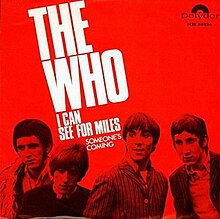
My Generation is the debut studio album by English rock band the Who, released on 3 December 1965 by Brunswick Records in the United Kingdom, and Festival Records in Australia. In the United States, it was released on 25 April 1966 by Decca Records as The Who Sings My Generation, with a different cover and a slightly altered track listing. Besides the members of the Who, being Roger Daltrey (vocals), Pete Townshend (guitar), John Entwistle (bass) and Keith Moon (drums), the album features contributions by session musician Nicky Hopkins (piano).

The Who Sell Out is the third studio album by the English rock band the Who. It was released on 15 December 1967 by Track Records in the UK and Decca Records in the US. A concept album, The Who Sell Out is structured as a collection of unrelated songs interspersed with fake commercials and public service announcements, including the second track "Heinz Baked Beans". The album purports to be a broadcast by pirate radio station Radio London. The reference to "selling out" was an intended irony, as the Who had been making real commercials during that period of their career, some of which are included as bonus tracks on the remastered CD.

"Norwegian Wood (This Bird Has Flown)" otherwise known as simply "Norwegian Wood", is a song by the English rock band the Beatles from their 1965 album Rubber Soul. It was written mainly by John Lennon, with lyrical contributions from Paul McCartney, and credited to the Lennon–McCartney songwriting partnership. Influenced by the introspective lyrics of Bob Dylan, the song is considered a milestone in the Beatles' development as songwriters. The track features a sitar part, played by lead guitarist George Harrison, that marked the first appearance of the Indian string instrument on a Western rock recording. The song was a number 1 hit in Australia when released on a single there in 1966, coupled with "Nowhere Man".

"Helter Skelter" is a song by the English rock band the Beatles from their 1968 album The Beatles. It was written by Paul McCartney and credited to Lennon–McCartney. The song was McCartney's attempt to create a sound as loud and dirty as possible. It is regarded as a key influence in the early development of heavy metal. In 1976, the song was released as the B-side of "Got to Get You into My Life" in the United States, to promote the Capitol Records compilation Rock 'n' Roll Music.

"Let It Be" is a song by the English rock band the Beatles, released on 6 March 1970 as a single, and as the title track of their album Let It Be. It was written and sung by Paul McCartney, and credited to the Lennon–McCartney partnership. The single version of the song, produced by George Martin, features a softer guitar solo and the orchestral section mixed low, compared with the album version, produced by Phil Spector, featuring a more aggressive guitar solo and the orchestral sections mixed higher.

"My Generation" is a song by the English rock band the Who, written by guitarist and primary songwriter Pete Townshend. One of the band's most recognizable songs, it was placed number 11 by Rolling Stone on its list of the “500 Greatest Songs of All Time” in 2004 and 2010, re-ranked number 232 in the 2021 edition. It became part of The Rock and Roll Hall of Fame's 500 Songs that Shaped Rock and Roll and is inducted into the Grammy Hall of Fame for "historical, artistic and significant" value. It is considered one of the band's signature songs.

"Rain" is a song by the English rock band the Beatles, released on 30 May 1966 as the B-side of their "Paperback Writer" single. Both songs were recorded during the sessions for Revolver, although neither appear on that album. "Rain" was written by John Lennon and credited to the Lennon–McCartney partnership. He described its meaning as "about people moaning about the weather all the time".
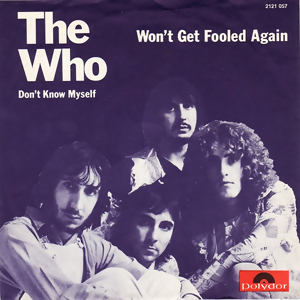
"Won't Get Fooled Again" is a song by the English rock band the Who, written by guitarist and primary songwriter Pete Townshend. It was released as a single in June 1971, reaching the top 10 in the UK, while the full eight-and-a-half-minute version appears as the final track on the band's 1971 album Who's Next, released that August. In the US, the single entered Billboard on 17 July, reaching No. 15.
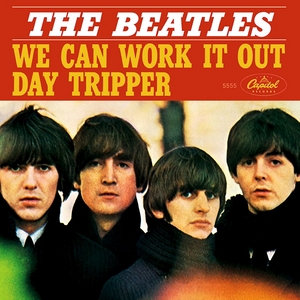
"Day Tripper" is a song by the English rock band the Beatles that was released as a double A-side single with "We Can Work It Out" in December 1965. The song was written primarily by John Lennon with some contributions from Paul McCartney and was credited to the Lennon–McCartney partnership. Both songs were recorded during the sessions for the band's Rubber Soul album. The single topped charts in Britain, Ireland, the Netherlands and Norway. In the United States, "Day Tripper" peaked at number five on the Billboard Hot 100 chart and "We Can Work It Out" held the top position.

"Birthday" is a song by the English rock band the Beatles from their 1968 double album The Beatles. Written by John Lennon and Paul McCartney, mainly by McCartney, it is the opening track on the third side of the LP. Surviving Beatles Paul McCartney and Ringo Starr performed it for Starr's 70th birthday at Radio City Music Hall on 7 July 2010.
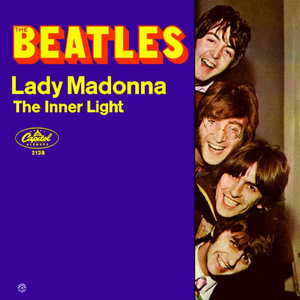
"Lady Madonna" is a song by the English rock band the Beatles, written primarily by Paul McCartney and credited to Lennon–McCartney. In March 1968 it was released as a mono non-album single, backed with "The Inner Light". The song was recorded on 3 and 6 February 1968, before the Beatles left for India, and its boogie-woogie style signalled a more conventional approach to writing and recording for the group following the psychedelic experimentation of the previous two years.
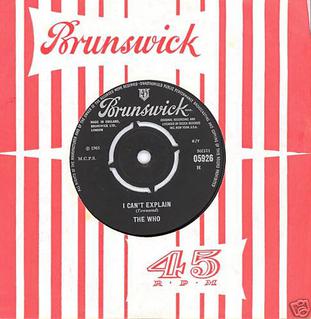
"I Can't Explain" is a song by English rock band the Who, written by Pete Townshend, and produced by Shel Talmy. The song was released as a single in the United States on 19 December 1964 by Decca and on 15 January 1965 in the United Kingdom by Brunswick. It was the band's second single release and first under the Who name.

"5:15" is a song written by Pete Townshend of British rock band The Who. Part of the band's second rock opera, Quadrophenia (1973), the song was also released as a single and reached No. 20 on the UK Singles Chart, while the 1979 re-release reached No. 45 on the Billboard Hot 100.
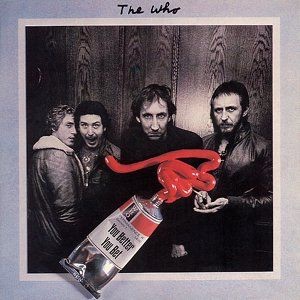
"You Better You Bet" is a song by British rock band the Who, appearing as the first track on their 1981 album Face Dances. It is sung by frontman Roger Daltrey with backing vocals from Pete Townshend and bassist John Entwistle.
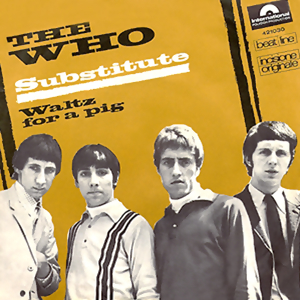
"Substitute" is a song by the English rock band the Who, written by Pete Townshend. Released in March 1966, the single reached number five in the UK and was later included on the compilation album Meaty Beaty Big and Bouncy in 1971. In 2006, Pitchfork ranked "Substitute" at number 91 on the "200 Greatest Songs of the 1960s".

"I'm Free" is a song written by Pete Townshend and performed by the Who on the album Tommy. The song has since been released as a single, becoming one of the best known tracks from Tommy.

"Mary Anne with the Shaky Hand" is a song by the English rock band the Who. It was written by Pete Townshend and released on their 1967 album The Who Sell Out. The best known version of the song has an arrangement using acoustic guitar and Latin percussion instruments.

"La-La-La-Lies" is the fourth track on the Who's debut album My Generation. It was written by lead guitarist Pete Townshend.

"Join Together" is a song by British rock band the Who, first released as a non-album single in June 1972. The song has since been performed live multiple times and has appeared on numerous compilation albums.

"Relay" is a song written by Pete Townshend, the guitarist of the Who, for the band's aborted Lifehouse project. The song was also released as a moderately successful single in 1972. It was also the last non-album single by the Who until "Real Good Looking Boy", 32 years later.
